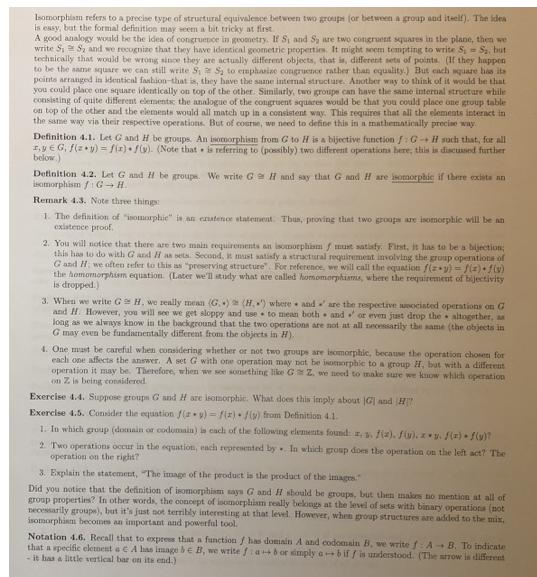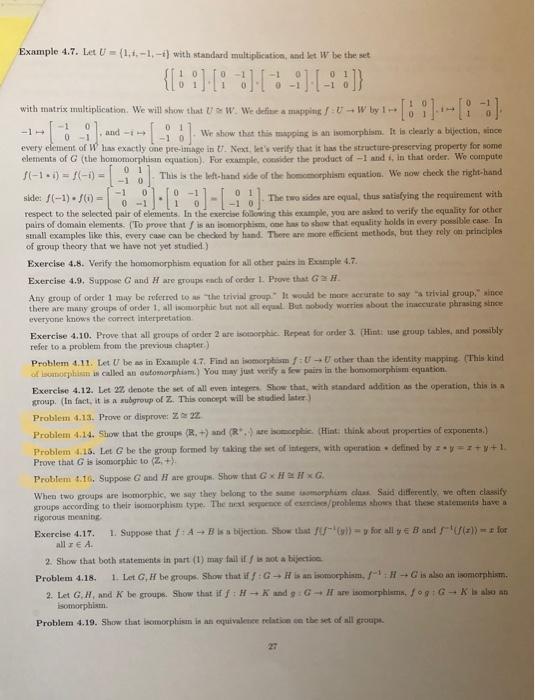Answered step by step
Verified Expert Solution
Question
1 Approved Answer
Isomorphiam refers to a precise type of structural equivalence between two groups (or between a group and itself). The idea is easy, but the


Isomorphiam refers to a precise type of structural equivalence between two groups (or between a group and itself). The idea is easy, but the formal definition may seem a bit tricky at first. A good analogy would be the idea of congruence in geometry. If S, and S, are two congruent squares in the plane, then we write S S and we recognize that they have identical geometric properties. It might seem tempting to write S S, but technically that would be wrong since they are actually different objects, that is, different sets of points. (If they happen to be the same square we can still write S S to emphasize congruence rather than equality.) But each square has its points arranged in identical fashion-that is, they have the same internal structure. Another way to think of it would be that you could place one square identically on top of the other. Similarly, two groups can have the same internal structure while consisting of quite different elements the analogue of the congruent squares would be that you could place one group table on top of the other and the elements would all match up in a consistent way. This requires that all the elements interact in the same way via their respective operations. But of course, we need to define this in a mathematically precise way Definition 4.1. Let G and H be groups. An isomorphism from G to H is a bijective function G+H such that, for all 1,9 G, f(z y) = fir) f(y). (Note that is referring to (possibly) two different operations here, this is discussed further below.) Definition 4.2. Let G and H be groups. We write GH and say that G and H are isomorphic if there exists an isomorphism / G H. Remark 4.3. Note three things: 1. The definition of "isomorphie" is an existence statement. Thus, proving that two groups are isomorphic will be an existence proof. 2. You will notice that there are two main requirements an isomorphism f must satisfy. First, it has to be a bijection; this has to do with G and H as sets. Second, it must satisfy a structural requirement involving the group operations of G and H: we often refer to this as "preserving structure". For reference, we will call the equation f(z+y)=f(z)-f(x) the homomorphism equation. (Later we'll study what are called homomorphiams, where the requirement of bijectivity is dropped.) 3. When we write GH, we really mean (G.) (H.') where and and H. However, you will see we get sloppy and use to mean both long as we always know in the background that the two operations are not at all necessarily the same (the objects in G may even be fundamentally different from the objects in H). are the respective woocisted operations on G and or even just drop the altogether, as 4. One must be careful when considering whether or not two groups are isomorphic, because the operation chosen for each one affects the answer. A set G with one operation may not be isomorphic to a group H, but with a different operation it may be. Therefore, when we see something like G Z. we need to make sure we know which operation on Z is being considered. Exercise 4.4. Suppose groups G and I are isomorphic. What does this imply about G and H Exercise 4.5. Consider the equation f(-y)-f(x) f(y) from Definition 4.1. 1. In which group (domain or codomain) is each of the following elements found , s. f(x). f(u). z. f(x) + f(y)? 2. Two operations occur in the equation, each represented by. In which group does the operation on the left act? The operation on the right? 3. Explain the statement, "The image of the product is the product of the images. Did you notice that the definition of isomorphism says G and H should be groups, but then makes no mention at all of group properties? In other words, the concept of isomorphism really belongs at the level of sets with binary operations (not necessarily groups), but it's just not terribly interesting at that level. However, when group structures are added to the mix, isomorphism becomes an important and powerful tool. Notation 4.6. Recall that to express that a function / has domain A and codomain B, we write f: A-B. To indicate. that a specific element a c A has image & B, we write f: a b or simply ab if / is understood. (The arrow is different - it has a little vertical bar on its end.) Example 4.7. Let U=(1,1,-1,-) with standard multiplication, and let W be the set (8848 GHAHAND --3) and-1- 0 -1 [48] We show that this mapping is an isomorphism. It is clearly a bijection, since 01 f(-1+i)=f(-1)= -1 0 every element of W has exactly one pre-image in U. Next, let's verify that it has the structure-preserving property for some elements of G (the homomorphism equation). For example, consider the product of -1 and i, in that order. We compute This is the left-hand side of the homomorphism equation. We now check the right-hand The two sides are equal, thus satisfying the requirement with respect to the selected pair of elements. In the exercise following this example, you are asked to verify the equality for other pairs of domain elements. (To prove that is an isomorphism, one has to show that equality holds in every possible case. In small examples like this, every case can be checked by hand. There are more efficient methods, but they rely on principles of group theory that we have not yet studied.) side: f(-1) f(1) = {]-[ -1 0 0-1 1 0 with matrix multiplication. We will show that UW. We define a mapping f:U-W by 1 -1 Exercise 4.8. Verify the homomorphism equation for all other pairs in Example 4.7. Exercise 4.9. Suppose G and H are groups each of order 1. Prove that GH. Any group of order 1 may be referred to as "the trivial group." It would be more accurate to say "a trivial group," since. there are many groups of order 1, all isomorphic but not all equal. But nobody worries about the inaccurate phrasing since everyone knows the correct interpretation Exercise 4.10. Prove that all groups of order 2 are isomorphic. Repeat for order 3. (Hint: use group tables, and possibly refer to a problem from the previous chapter.) Problem 4.11. Let U be as in Example 4.7. Find an isomorphism f:U-U other than the identity mapping (This kind of isomorphism is called an outomorphism.) You may just verify a few pairs in the homomorphism equation. Exercise 4.12. Let 22 denote the set of all even integers. Show that, with standard addition as the operation, this is a group. (In fact, it is a subgroup of Z. This concept will be studied later) Problem 4.13. Prove or disprove: Z 22 Problem 4.14. Show that the groups (R,+) and (R.) are isomorphic. (Hint: think about properties of exponents.) Problem 4.15. Let G be the group formed by taking the set of integers, with operation defined by zy=z+y+1. Prove that G is isomorphic to (2, +). Problem 4.16. Suppose G and H are groups. Show that GxHHxG. When two groups are isomorphic, we say they belong to the same somorphiam class Said differently, we often classify groups according to their isomorphism type. The next sequence of exercises/problems shows that these statements have a rigorous meaning. Exercise 4.17. 1. Suppose that f: A-B is a biljection. Show that fif())-g for all y B and f(f(x)) = for all z A. 2. Show that both statements in part (1) may fall if f is not a bijection Problem 4.18. 1. Let G, H be groups. Show that if f: G H is an isomorphism, f H-G is also an isomorphism. 2. Let G, H, and K be groups. Show that if f: H-K and 9: G-II are isomorphisms, fog: G-K is also an isomorphism. Problem 4.19. Show that isomorphism is an equivalence relation on the set of all groups.
Step by Step Solution
There are 3 Steps involved in it
Step: 1

Get Instant Access to Expert-Tailored Solutions
See step-by-step solutions with expert insights and AI powered tools for academic success
Step: 2

Step: 3

Ace Your Homework with AI
Get the answers you need in no time with our AI-driven, step-by-step assistance
Get Started


